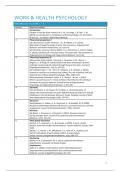Samenvatting
Summary Work and Health Psychology
- Vak
- (760434B4)
- Instelling
- Tilburg University (UVT)
This summary is about Work and Health Psychology. The material is based on various scientific articles and the course material. The summary zooms in on Job demandss-resources theory, idiosyncratic deals, job crafting, wise proactivity framework, job resources, personal resources, work-family confli...
[Meer zien]




